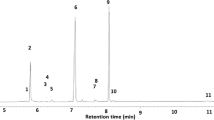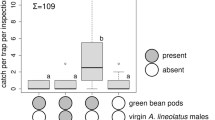Abstract
Previous work has shown that male sorghum plant bugs, Stenotus rubrovittatus (Matsumura) (Heteroptera: Miridae), are more attracted to young virgin females than to old virgin females and are not attracted to mated females. Therefore, we examined the effects of age and mating status on female sex pheromone levels. The pheromone components, hexyl butyrate, (E)-hex-2-en-1-yl butyrate, and (E)-4-oxohex-2-enal, were collected from females in two different ways. First, the compounds were extracted from whole bodies of each female and quantified by gas chromatography-mass spectrometry (GC-MS). Pheromone levels extracted from virgin female bodies decreased with age. In females that had just mated, pheromone levels did not differ from those of virgin females, and pheromone levels in mated females remained relatively constant up to 15 d after mating. This absence of change in pheromone levels extracted from whole bodies of mated females is not congruent with previous reports of lack of male attraction to these females. In a second method for pheromone recovery (adsorption on a PDMS-coated stir bar), GC-MS analysis showed that mated females released lower amounts of pheromone components compared to those emitted by virgin females of the same age (4 d). As was the case with whole body extracts, young virgin females (3 d) released higher amounts of pheromone components than did old virgin females (8 d). The results suggest that male response in S. rubrovittatus is dictated more by the quantities of pheromone components released into the volatile headspace by females than by the quantities present in the body.



Similar content being viewed by others
References
Babilis, N. A. and Mazomenos, B. E. 1992. Pheromone production in Sesamia nonagrioides: diel periodicity and effect of age and mating. J. Insect Physiol. 38:561–564.
Bicchi, C., Cordero, C., Liberto, E., Rubiolo, P., Sgorbini, B., David, F., and Sandra, P. 2005. Dual-phase twisters: a new approach to headspace sorptive extraction and stir bar sorptive extraction. J. Chromatogr. A 1094:9–16.
Byers, J. A. 2006. Production and predator-induced release of volatile chemicals by the plant bug Lygus hesperus. J. Chem. Ecol. 32:2205–2218.
Delisle, J. and Royer, L. 1994. Changes in pheromone titer of oblique-banded leafroller, Choristoneura rosaceana, virgin females as a function of time of day, age, and temperature. J. Chem. Ecol. 20:45–69.
Fukuyama, M., Adati, T., Higuchi, H., and Takahashi, A. 2007. Attractiveness of females to males in the rice leaf bug, Trigonotylus caelestialium (Kirkaldy)—effect of mating status and age of females. Jpn. J. Appl. Entomol. Zool. 51:135–137 (in Japanese with English summary).
Giebultowicz, J. M., Raina, A. K., Uebel, E. C., and Ridgway, R. L. 1991. Two-step regulation of sex pheromone decline in mated gypsy moth females. Arch. Insect Biochem. Physiol. 16:95–105.
del Mazo-Cancino, A., Malo, E. A., Cruz-López, L., and Rojas, J. C. 2004. Diel periodicity and influence of age and mating on female sex pheromone titre in Estigmene acrea (Lep., Arctiidae). J. Appl. Entomol. 128:459–463.
McClure, M., Whistlecraft, J., and McNeil, J. N. 2007. Courtship behavior in relation to the female sex pheromone in the parasitoid, Aphidius ervi (Hymenoptera: Braconidae). J. Chem. Ecol. 33:1946–1959.
Okutani-Akamatsu, Y., Watanabe, T., and Azuma, M. 2007. Mating attraction by Stenotus rubrovittatus (Heteroptera: Miridae) females and its relationship to ovarian development. J. Econ. Entomol. 100:1276–1281.
Okutani-Akamatsu, Y., Watanabe, T., and Azuma, M. 2009. Mating behavior and oviposition of the sorghum plant bug, Stenotus rubrovittatus (Matsumura) (Heteroptera: Miridae), under laboratory conditions. Jpn. Appl. Entomol. Zool. 53:13–20 (in Japanese with English summary).
Raina, A. K., Klun, J. A., and Stadelbacher, E. A. 1986. Diel periodicity and effect of age and mating on female sex pheromone titer in Heliothis zea (Lepidoptera: Noctuidae). Ann. Entomol. Soc. Am. 79:128–131.
Ramaswamy, S. B. and Cohen, N. E. 1992. Ecdysone: an inhibitor of receptivity in the moth, Heliothis virescens? Naturwissenschaften 79:29–31.
SAS Institute 2007. JMP: Statics and Graphics Guide, version 7.0.1. SAS Institute, Cary, NC.
Shu, S., Mbata, G. N., and Ramaswamy, S. B. 1998. Female sex pheromone in Callosobruchus subinnotatus (Coleoptera: Bruchidae): production and male responses. Ann. Entomol. Soc. Am. 91:840–844.
Sokal, R. R. and Rohlf, F. J. 1995. Biometry, 3rd ed. Freeman, New York.
Tang, J. D., Charlton, R. E., Cardé, R. T., and Yin, C.-M. 1992. Diel periodicity and influence of age and mating on sex pheromone titer in gypsy moth, Lymantria dispar (L.). J. Chem. Ecol. 18:749–760.
Yasuda, T., Shigehisa, S., Yuasa, K., Okutani-Akamatsu, Y., Teramoto, N., Watanabe, T., and Mochizuki, F. 2008. Sex attractant pheromone of the sorghum plant bug Stenotus rubrovittatus (Matsumura) (Heteroptera: Miridae). Appl. Entomol. Zool. 43:219–226.
Acknowledgments
We thank Dr. T. Watanabe of National Agricultural Research Center (NARC) for suggestions and encouragement, Dr. T. Mitsunaga of NARC for advice on statistical analyses, and two anonymous reviewers for their valuable comments. This study was partly supported by a Grant-in-Aid for Research Projects Utilizing Advanced Technologies in Agriculture, Forestry and Fisheries from the Ministry of Agriculture, Forestry, and Fisheries of Japan.
Author information
Authors and Affiliations
Corresponding author
Electronic Supplementary Material
Below is the link to the electronic supplementary material.
Supplemental Fig. 1
Standard linear calibration curves for each pheromone component from female Stenotus rubrovittatus. The y-axis indicates the peak area ratio of each component to the internal standard (heptadecane, R t = 10.04 min), while the x-axis indicates the quantity of each component. The amounts of hexyl butyrate (R t = 7.65 min), (E)-hex-2-en-1-yl butyrate (R t = 8.19 min), and (E)-4-oxohex-2-enal (R t = 9.31 min) in the extracts from female bodies were quantified by gas chromatography-mass spectrometry in selected ion monitoring (SIM) mode. Two ions were monitored for each component, m/z 129 and 89 for hexyl butyrate, m/z 170 and 100 for (E)-hex-2-en-1-yl butyrate, m/z 112 and 83 for (E)-4-oxohex-2-enal, and m/z 240 and 99 for heptadecane. Quantification was based on the former ions of the ion pairs for each component, whereas the latter ions served as reference or qualifier ions for diagnosis and quantitative analysis. The presence of a qualifier ion in the correct amount relative to the target ion gives evidence of correct target compound identification (http://www.chem.agilent.com/Library/Support/Documents/a05214.pdf, accessed April 18, 2010). (DOC 128 kb)
Supplemental Fig. 2
Mass spectra of (a) hexyl butyrate, (b) (E)-hex-2-en-1-yl butyrate, (c) (E)-4-oxohex-2-enal, and (d) heptadecane (internal standard) demonstrating that neither the analytes nor the standard had co-eluting peaks representing chemical compounds that would confound the quantitative analysis. The mass spectra were recorded from whole-body extracts of 5-d virgin female Stenotus rubrovittatus. (DOC 83 kb)
Rights and permissions
About this article
Cite this article
Oku, K., Yasuda, T. Effects of Age and Mating on Female Sex Attractant Pheromone Levels in the Sorghum Plant Bug, Stenotus rubrovittatus (Matsumura). J Chem Ecol 36, 548–552 (2010). https://doi.org/10.1007/s10886-010-9795-1
Received:
Revised:
Accepted:
Published:
Issue Date:
DOI: https://doi.org/10.1007/s10886-010-9795-1




